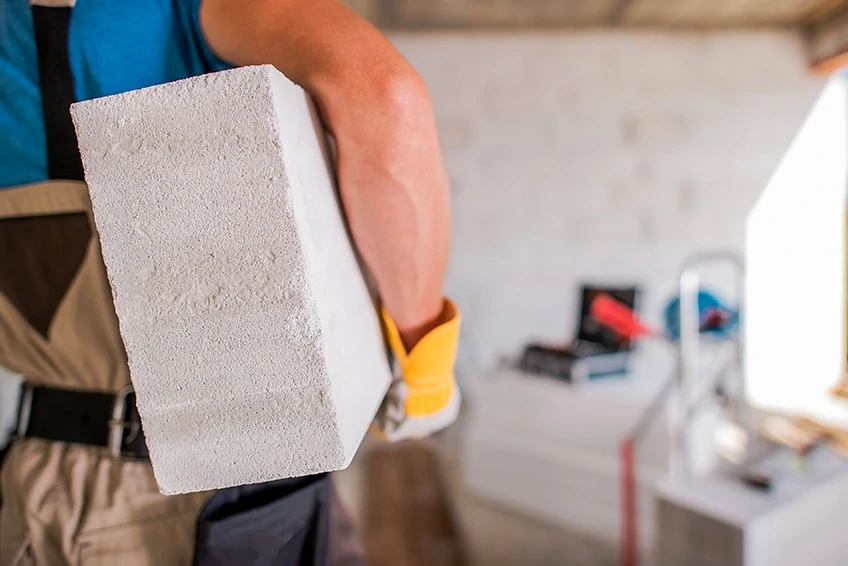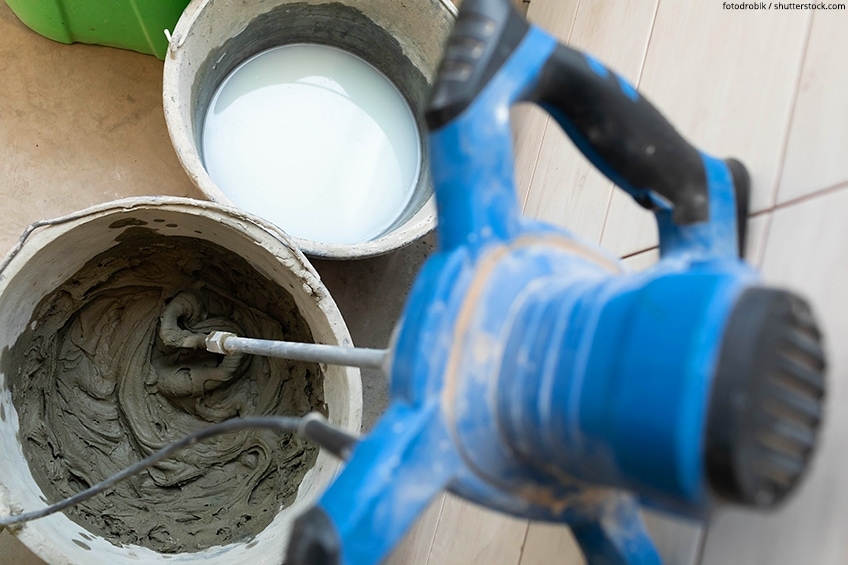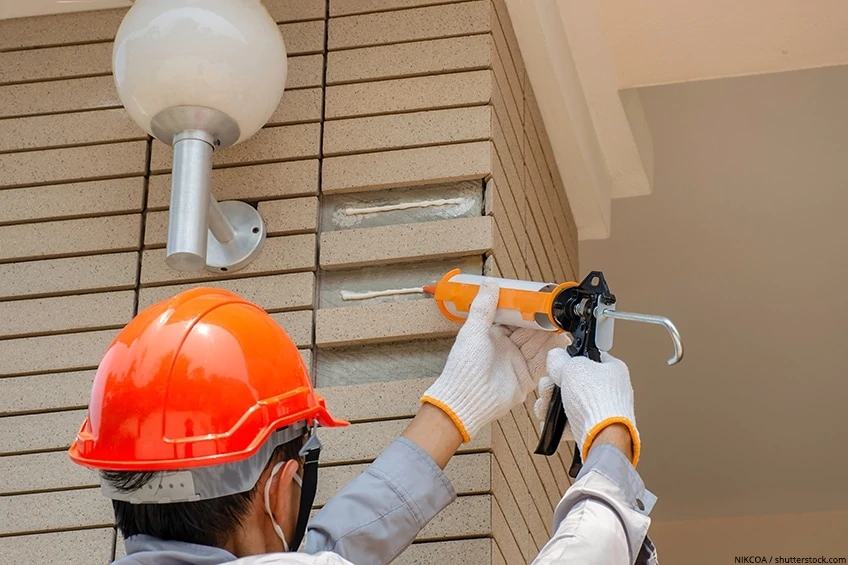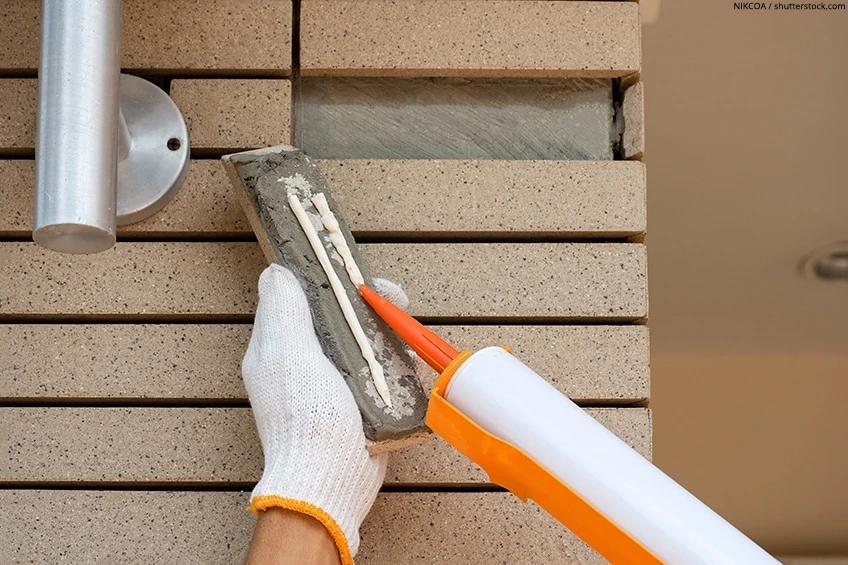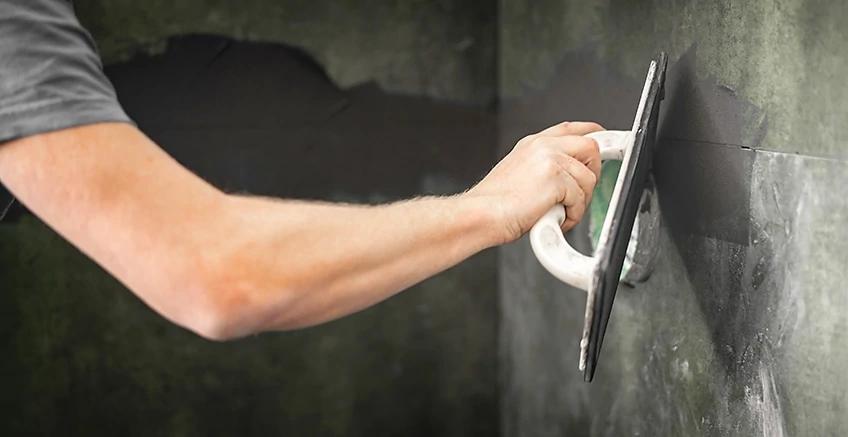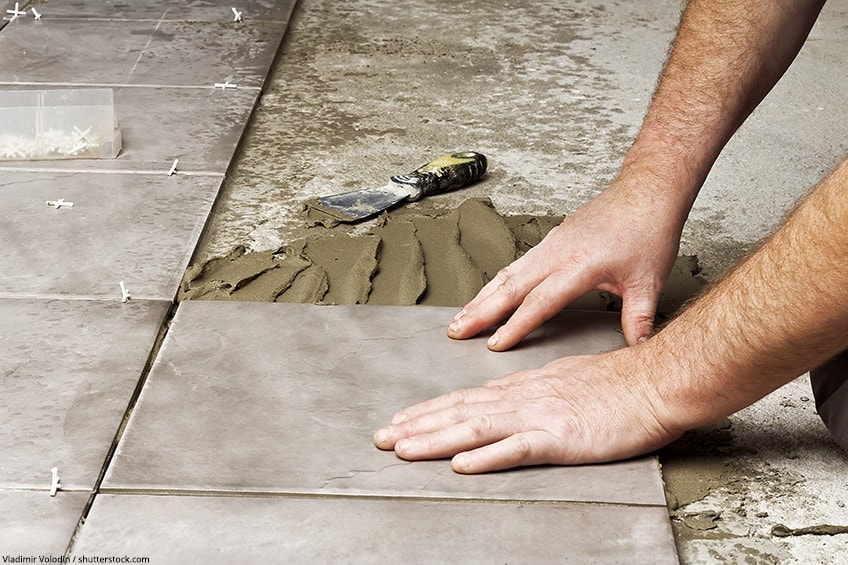Best Concrete Bonding Agent – Guide on Adhesive for Concrete
This post may contain affiliate links. We may earn a small commission from purchases made through them, at no additional cost to you. You help to support resin-expert.com
Concrete has been one of the most important building materials of all for decades. Its areas of application are diverse, making this material interesting not only for industry but also for home users. Not only is the casting of concrete important, but also the joining. For this purpose, various adhesives for concrete are available on the market today. In our concrete adhesive guide, we will show you how to use them optimally, such as bonding wood to concrete.
Table of Contents
- Concrete Properties
- Applications of Concrete
- Two-Component Concrete Adhesive
- Use a Concrete Glue Power Adhesive
- Gluing Concrete to Concrete with an Assembly Adhesive
- Fill and Level Concrete Surfaces with a Cement Adhesive and Filler
- Seal Concrete on Parts of a Building with a Silicone Concrete Adhesive
- Frequently Asked Questions
Concrete Properties
Concrete celebrates a special success story precisely because of its positive material properties:
- Concrete has a very high resistance to wear and tear.
- It has a high pH value and therefore optimally protects steel reinforcements against corrosion.
- It can serve as fire protection, as it has good fire protection properties.
- It also offers optimum protection against moisture.
- Its compressive strength is at least 20 N/mm².
- Its shaping possibilities are almost infinite, making it interesting not only in the building industry, but also for small users and artists.
- Its application is simple once you get the hang of it.
Applications of Concrete
As noted, concrete is used not only for industrial purposes, but also by small users. The areas of application for concrete are highly diverse:
- Because of its high compressive strength and its resistance to wear of all kinds, it is often used as a material for load-bearing components; these can be ceilings as well as walls or sheathing for steel girders.
- Walls, floors, and floor slabs, both exterior and interior, are very often cast in concrete.
- Concrete is used for prestressed concrete pools.
- You can get prefabricated concrete elements for the construction of all types of buildings.
- Concrete can be used as breakwater blocks and counterweights for cranes.
- Various stands such as sunshades are made with concrete.
- Various art elements are made out of concrete.
- Concrete is frequently used for bed borders, planters, and other garden elements.
For these purposes, concrete must often also be joined. Nowadays, it is very easy to bond concrete if you use the right concrete adhesive. Concrete adhesives are distinguished in particular according to the way they are used:
- For joining two concrete components, either pointwise or two-dimensionally; often with the aid of a polymer adhesive.
- As mortar for joining masonry or concrete components.
- As a tile adhesive for the permanent joining of tiles with the substrate.
- For the sealing of the substrate with the help of acrylic or silicone.
For the do-it-yourselfer, there are various things to consider in the bonding process, especially if you want to bond other materials such as glass or wood to concrete. In the next chapters, we will introduce you to the most suitable adhesives for concrete and reveal tips and tricks for their application.
Two-Component Concrete Adhesive
Due to their adhesive properties, two-component (2K) adhesives for concrete are particularly suitable for surface bonding. These consist of two different substances that trigger a chemical reaction as soon as they come into contact with each other. Different versions are available: either both components are supplied in separate containers and must be mixed by the user, or the adhesive is sold immediately in a practical double-chamber cartridge. The latter saves you mixing.
Such 2K concrete adhesives are usually based on epoxy resin. They are particularly suitable for larger applications such as:
- For filling and filling of various surfaces
- For bonding various materials such as steel, concrete, stone, wood and many more
- For repairing damage to concrete surfaces
- For repairing concrete and cement mortar layers
- For closing cracks and holes
It is always important to consider the application for which the concrete adhesive is needed. Concrete adhesives that are to be used for outdoor repair work, for example, must be highly resistant to weathering.
Fortunately, we can make a solid recommendation. In our concrete adhesive test, we took a close look at various properties of concrete adhesives and decided on the following winner: PC PRODUCTS PC-Concrete Two-Part Epoxy Adhesive Paste. This epoxy paste is perfect for filling and repairing cracks and holes in concrete, as a grout, and much more.
This product is moisture-resistant and can be used in both indoor and outdoor environments. You can even apply this epoxy to vertical surfaces. You will have a generous working time of 20 minutes with which you can adjust the adhesive, after which time it will take approximately four hours to cure.
- Two-part epoxy adhesive paste to fill and repair cracks in concrete
- High-tack paste resists moisture for application in damp environments
- For indoor and outdoor applications from -20 to +115 degrees F
Pros
- Can be used for filling and repairing cracks
- Can be used to anchor concrete
- Long working time
- Moisture-resistant
- Can be used outdoors and indoors
- Suitable for vertical surfaces
- Easy to use
Cons
- A caulking gun is required for application
Precisely because of the many benefits to this product, we unreservedly recommend this epoxy adhesive by PC Products.
Areas of Application
If you want to bond wood to concrete, a two-component concrete adhesive can serve you well. A two-component adhesive is also an invaluable aid for bonding other materials, such as thermosetting plastics or bare metals to concrete. If you want to apply insulation to concrete, you should also use a two-component concrete adhesive, as this is perfect for insulating foams. It is essential to use an adhesive that is flame retardant and solvent-free. The surface of very smooth materials should always be roughened before processing.
Application
- The application of all types of adhesives is preceded by thoroughly cleaning the substrate from dust, dirt, grease, and oil residues, otherwise the adhesive properties of the glue may be impaired.
- Using a two-component adhesive for concrete is not difficult. Mix the two components together according to the instructions in the data sheet. If you have purchased a double chamber cartridge, this step is not necessary.
- After mixing, the working time begins, also known as the pot life. Work must now be carried out quickly, because when the concrete adhesive begins to harden, lumps form that make further work impossible.
- Depending on the application, apply the adhesive either selectively or over a wide area. Be sure to follow the data sheet for exact application. Join the two substrates together and fix them if necessary. Immediately remove any adhesive residue at the glue line.
- Ensure that sufficient personal protective measures are taken, such as wearing gloves, and that the workplace is adequately ventilated.
- Allow the adhesive seam to cure sufficiently. Here, too, follow the manufacturer’s instructions. As a rule, there is a solid hand strength after only a few minutes, and complete curing after 24 hours at the latest, depending on the ambient temperature and humidity.
Use a Concrete Glue Power Adhesive
If you want to join concrete by gluing instead of drilling, bonding by means of power adhesive is actually the simplest variant. This is suitable for almost all bonding and materials. In particular, it is the method of choice for selective bonding. We present here the Loctite PL Premium Polyurethane Construction Adhesive for gluing instead of drilling, which brings several advantages to the user.
This 100% polyurethane adhesive is safe to use and VOC-compliant. You can use this product on indoor and outdoor applications with a guarantee that the bond will last for as long as the surface to which it has been applied. Indeed, this polyurethane adhesive is up to eight times stronger than most other construction-grade adhesives, and is a great choice for bonding a wide range of construction materials. This product is waterproof, will cure in cold climates, and can be painted once cured.
- Safe to use, repositionable and VOC compliant
- Constructed of 100% polyurethane
- 8 times stronger than your typical construction adhesive
Pros
- VOC-compliant
- Can be used indoors and outdoors
- Long-lasting bond
- Waterproof
- Will cure in cold temperatures
- Paintable
- Easy to use
- No additional tools required for application
Cons
- Not ideal for particularly sleek surfaces
Since there is only one disadvantage here, we give a crystal-clear recommendation at this point!
Areas of Application
A power adhesive for concrete can be particularly interesting for the small user if quick, selective, or simple bonding is to be carried out. Especially in the workshop, such an adhesive for concrete is an invaluable help, because it does not require any other materials. You do not have to search for tools nor will you make any noise, as is the case with screwing, for example. As a result, such work can be done even late at night or on holidays. Examples of applications for concrete bonding are the following:
- These concrete adhesives are used in the assembly of glass shower enclosures.
- You can repair decorative elements with this concrete glue.
- You can use the concrete glue to repair floor coverings or walls.
- Masonry adhesives can be used in the installation of concrete cladding on walls.
- Adhesive can be used for the sealing of concrete elements against water and other liquids.
- Use this adhesive as an insertion of various fastening elements in previously drilled holes.
Application
Before you start bonding concrete, you need to consider a few points. First of all, the required adhesive strength should be determined, as the available adhesives have a wide range of adhesive strength. Sometimes, only an adhesive with relatively low bonding strength is needed. This is often the case for smaller bondings.
This brings us to another question that needs to be answered: Does a larger area need to be bonded or is it to be applied selectively? When bonding a large area, it is advisable to work either with a brush, a spatula, or a cartridge. It should also be clarified whether adhesive beads have sufficient adhesive strength or whether the distribution of the concrete adhesive must be carried out over the entire area.
Other important points are:
- Is the application based outdoors or indoors?
- Does the work have to be impermeable to water?
- What combination of materials will be used for bonding? Is the concrete to be bonded with concrete or with another material?
Only after these questions have been clarified can the adhesive be applied. This depends on the type of adhesive used. We will present these to you in the following and go into detail about the respective application.
Gluing Concrete to Concrete with an Assembly Adhesive
Assembly adhesive is usually heavy-duty and suitable for both indoor and outdoor use. An included joint tip makes it easy to apply, so even very small glues can be applied without any problems. At this point, we recommend the Gorilla Heavy Duty Ultimate Construction Adhesive. This has a particularly high adhesive strength, as well as many other advantages.
This is a highly durable product by the Gorilla brand that offers a tough and versatile adhesive that can be used on many different surfaces. It is completely waterproof and can even be used on underwater surfaces. This adhesive works instantly and can also be used as a gap-filler. You will also be able to paint over this adhesive.
- Tough, versatile, and completely waterproof
- Instant grab to a variety of surfaces
- Paintable and gap-filling
Pros
- Extremely durable
- Can be used on several surfaces
- 100% waterproof
- Instant adhesion
- Works as a gap-filler
- Paintable
Cons
- Adhesion is not as instant as advertized
With one slight disadvantage, this assembly adhesive from Gorilla receives a clear recommendation from us.
Areas of Application
Especially when concrete is to be bonded to other materials, a good assembly adhesive is usually used. This has a high adhesive strength and is therefore able to form extremely strong and stable bonds. It is therefore ideally suited to replace doweling, screwing, and drilling. Especially where these methods are not possible, bonding with an assembly adhesive can be an optimal alternative.
Application
Assembly adhesive is usually supplied in a cartridge, with which the adhesive contained is applied in the form of a bead on one side. If necessary, it can then be spread over a large area using a spatula. Beforehand, of course, the substrate should be cleaned of dirt, dust, oil, and grease to optimize adhesion.
Any adhesive that escapes must be removed immediately from the glued seam. Observe the curing time by referring to the manufacturer’s data sheet. To be on the safe side, give the adhesive seam a little more time than specified.
Fill and Level Concrete Surfaces with a Cement Adhesive and Filler
Filling and completely leveling concrete surfaces is not an easy task. The best way to do this is to use an epoxy resin-based filler. This two-component filler must first be stirred, which starts a chemical reaction between the resin and the hardener: The viscosity of the material continues to increase until the pot life has elapsed and the material is completely cured.
At this point, we can make a clear recommendation for PC-Products PC-11 Epoxy Adhesive Paste. This two-part epoxy adhesive paste is of a marine-grade, meaning that it can be bonded to materials in dry, wet, and even underwater areas. You can apply this adhesive to vertical and overhead applications both indoors and outdoors with ease. This adhesive paste is also resistant to mild chemicals, oils, as well as fresh and salt water. With a longer working time, this is the ideal product to use on larger projects that require repositioning or changes.
- Bonds materials in dry, wet, and underwater environments
- Can be used for indoor and outdoor applications
- Resists mild acids, caustics, detergents, gasoline, fuel oil, and water
Pros
- Marine-grade epoxy
- Works on vertical and overhead surfaces
- Can be used outdoors and indoors
- Chemical-resistant
- Resistant to fresh and salt water
- Longer working time
- Excellent value for money
Cons
- Thicker viscosity makes it difficult to mix by hand
- Finish is not particularly smooth
We are absolutely in favor of the PC Products epoxy adhesive paste, as its advantages clearly outweigh the few disadvantages.
Areas of Application
Filler for concrete is used wherever unevenness needs to be levelled or holes and cracks in the concrete need to be filled, such as in floor slabs or other substrates. A two-component filler is also the product of choice for faulty drill holes or for repairing cement mortar layers.
Application
First, remove all dirt, dust, oil, and grease from the substrate. Then, mix the putty according to the enclosed instructions. Use a spatula to fill the unevenness with the putty and smooth the compound. Observe the curing time according to the manufacturer’s instructions.
Seal Concrete on Parts of a Building with a Silicone Concrete Adhesive
If you want to seal a building, a chemical adhesive can be used. Such adhesives for concrete are based either on silicone or acrylic. They are easy to apply using a cartridge and reliably seal building parts such as basement foundations, rain gutters or even terraces. It should be noted that the adhesive properties of silicone adhesives are not as strong as those of many other adhesives. Here, the density properties of the silicone compound are particularly important.
We have tested silicone-based adhesives for concrete and the clear winner for us is General Electric (GE) Concrete and Masonry Silicone. This adhesive is resistant to the sun’s UV rays and heat as well as freezing, and can be rained upon within just a few hours after curing. Indeed, you can use this product on a number of surfaces in order to achieve a permanent and durable-yet-flexible bond. This silicone adhesive is waterproof and will not shrink or crack.
- Sun- and freeze-proof
- Waterproof and resistant to shrinking and cracking
- Flexible and durable
Pros
- Resistant to UV rays
- Resistant to extreme heat and freezing temperatures
- Quick to cure
- Waterproof
- Does not shrink or crack
- Flexible and durable
- Easy to use
Cons
- Dries to an unnatural gray color
This is the ideal product to use for sealing concrete, as it has a wide range of great advantages, making it excellent value for money.
Areas of Application
Particularly outdoors or in basements, it is often important to ensure optimum sealing of the walls and the substrate to prevent moisture from getting into the masonry. Here, an acrylic- or silicone-based chemical adhesive can do a good job. Reliable sealing of basements, balconies, terraces, gutters as well as other parts of the building can be easily achieved with such an adhesive for concrete.
As for the adhesive strength, it works best in combination with glass or ceramics. Especially smooth surfaces are joined very well by a silicone adhesive. So, if you want to bond glass to concrete, a silicone adhesive might be the way to go.
Application
Building silicone is supplied in a cartridge, with the aid of which it can be applied in bead form to the previously cleaned substrate. It can then be smoothed out if necessary. It is best to pick up any escaping adhesive immediately with a spatula.
Frequently Asked Questions
Is Gluing Concrete to Concrete Possible with Superglue?
For spot areas, a superglue is usually ideal; for larger areas, it is less suitable because of its rapid curing.
Can You Glue Wood to Concrete?
Wood can be bonded to concrete if you use a water-free reactive resin adhesive, as the porous wood could otherwise absorb the water contained in the adhesive. Ensure that the substrates to be bonded are adequately cleaned and thoroughly roughened.
Can You Use Masonry Adhesives to Glue Metal to Concrete?
Here, it depends on the metal, because each type of metal has different properties. In any case, roughen the surfaces well, clean them from all dirt, oil, and grease residues and use a two-component adhesive based on epoxy resin or polyurethane.
Can You Glue Stainless Steel to Wall?
You can bond stainless steel to wall by roughening the grease- and oil-free surfaces and using a polyurethane- or epoxy-based two-component adhesive. For bonding stainless steel to concrete, you can also use a two-component MMA-based adhesive.
Can You Glue Concrete to Glass?
Concrete can be bonded to glass using permanently elastic adhesives and sealants. You can also use two-component epoxy resin-based adhesives for this purpose.
Gluing concrete is also possible and even appropriate if you want to save time and work silently. With our instructions for gluing concrete, nothing can go wrong. We hope we have been able to help you!



